National Multi-Scenario Simulation of Low-Carbon Land Use to Achieve the Carbon-Neutrality Target in China
Abstract
1. Introduction
2. Data Sources and Processing
3. Methods
3.1. Research Framework
3.2. Land Use Simulation Based on the PLUS Model
3.2.1. PLUS Model
3.2.2. Parameter Settings
3.3. GeoSOS-FLUS Model
3.4. Extrapolation of Trends in Influencing Factors from 2030 to 2060
3.5. Scenario Settings
3.6. Model Simulation Accuracy Evaluation
3.7. Carbon Emission Calculation
3.7.1. Direct Carbon Emission Accounting Model for Land Use
3.7.2. Indirect Carbon Emission Accounting Model for Land Use
3.7.3. Land Use Net Carbon Emission Accounting
4. Results
4.1. Accuracy Evaluation
4.2. Analysis of the Spatiotemporal Evolution Characteristics of Land Use from 2030 to 2060
4.3. Analysis of the Spatiotemporal Evolution Characteristics of Land Use Carbon Emissions in China from 2000 to 2060
4.3.1. Dynamics of Land Use Carbon Emissions in China from 2000 to 2020
4.3.2. Dynamics of Land Use Carbon Emissions in China from 2030 to 2060
4.3.3. Analysis of the Spatiotemporal Characteristics of Land Use Carbon Emissions in China from 2030 to 2060
5. Discussion
5.1. Analysis of Carbon Emission Peaks in Multiple Scenarios in China from 2030 to 2060
5.2. Policy Suggestions
5.3. Advantages, Disadvantages and Prospects
6. Conclusions
Author Contributions
Funding
Data Availability Statement
Conflicts of Interest
References
- Yao, X.; Ye, B.; Lan, Y. Diurnal contrast of urban park cooling effects in a “Furnace city” using multi-source geospatial data and optimal parameters-based geographical detector model. Sustain. Cities Soc. 2024, 114, 105765. [Google Scholar] [CrossRef]
- Gu, C.; Guan, W.; Liu, H. Chineseurbanization2050: SDmodelingandprocess simulation. Sci. China Earth Sci. 2017, 60, 1067–1082. [Google Scholar] [CrossRef]
- Niu, L.D.; Pan, M. Research on dynamic simulation of land use change based on geographical weighted CLUE-S model. Int. J. Environ. Technol. Manag. 2021, 24, 49–61. [Google Scholar] [CrossRef]
- Liang, X.; Guan, Q.; Clarke, K.C. Understanding the drivers of sustainable land expansion using a patch-generating land use simulation (PLUS) model: A case study in Wuhan, China. Comput. Environ. Urban Syst. 2021, 85, 101569. [Google Scholar] [CrossRef]
- Wei, B.; Kasimu, A.; Reheman, R. Spatiotemporal characteristics and prediction of carbon emissions/absorption from land use change in the urban agglomeration on the northern slope of the Tianshan Mountains. Ecol. Indic. 2023, 151, 110329. [Google Scholar] [CrossRef]
- Ye, L.; Zhao, S.; Yang, H. Urban land use simulation and carbon-related driving factors analysis based on RF-CA in Shanghai, China. Ecol. Indic. 2024, 166, 112555. [Google Scholar] [CrossRef]
- Meiyappan, P.; Jain, A.K.; House, J.I. Increased influence of nitrogen limitation on CO2 emissions from future land use and land use change. Glob. Biogeochem. Cycles 2015, 29, 1524–1548. [Google Scholar] [CrossRef]
- Arneth, A.; Sitch, S.; Pongratz, J. Historical carbon dioxide emissions caused by land-use changes are possibly larger than assumed. Nat. Geosci. 2017, 10, 79–84. [Google Scholar] [CrossRef]
- Raupach, M.R.; Rayner, P.J.; Paget, M. Regional variations in spatial structure of nightlights, population density and fossil-fuel CO2 emissions. Energy Policy 2010, 38, 4756–4764. [Google Scholar] [CrossRef]
- Ghosh, T.; Elvidge, C.D.; Sutton, P.C. Creating a global grid of distributed fossil fuel CO2 emissions from nighttime satellite imagery. Energies 2010, 3, 1895–1913. [Google Scholar] [CrossRef]
- Zhao, J.; Ji, G.; Yue, Y. Spatio-temporal dynamics of urban residential CO2 emissions and their driving forces in China using the integrated two nighttime light datasets. Appl. Energy 2019, 235, 612–624. [Google Scholar] [CrossRef]
- Rahman, M.M.; Hasan, J. Evaluating the Impact of Green Spaces on Urban Heat Reduction in Rajshahi, Bangladesh Using the InVEST Model. Land 2024, 13, 1284. [Google Scholar] [CrossRef]
- Zhang, C.; Jia, Q.; Liu, Y. Evaluation and multi scenario simulation of ecosystem service value in Zhengzhou Metropolitan Area based on PLUS model. Meas. Sens. 2024, 32, 101079. [Google Scholar] [CrossRef]
- Wu, L.; He, Y.; Tan, Q. Land-use simulation for synergistic pollution and carbon reduction: Scenario analysis and policy implications. J. Environ. Manag. 2024, 356, 120603. [Google Scholar] [CrossRef] [PubMed]
- Xu, X.; Kong, W.; Wang, L. A novel and dynamic land use/cover change research framework based on an improved PLUS model and a fuzzy multiobjective programming model. Ecol. Inform. 2024, 80, 102460. [Google Scholar] [CrossRef]
- Chowdhury, P.K.R.; Brown, D.G. Modeling the effects of carbon payments and forest owner cooperatives on carbon storage and revenue in Pacific Northwest forestlands. Land Use Policy 2023, 131, 106725. [Google Scholar] [CrossRef]
- Yang, Y.; Tian, Y.; Zhang, Q. Impact of current and future land use change on biodiversity in Nanliu River Basin, Beibu Gulf of South China. Ecol. Indic. 2022, 141, 109093. [Google Scholar] [CrossRef]
- Aponte, C.; Kasel, S.; Nitschke, C.R. Structural diversity underpins carbon storage in Australian temperate forests. Glob. Ecol. Biogeogr. 2020, 29, 789–802. [Google Scholar] [CrossRef]
- Stas, M.S.; Le, C.T.; Tran, D.H. Logging intensity drives variability in carbon stocks in lowland forests in Vietnam. For. Ecol. Manag. 2020, 460, 117863. [Google Scholar] [CrossRef]
- Xu, F.; Chi, G. Spatiotemporal variations of land use intensity and its driving forces in China, 2000–2010. Reg. Environ. Change 2019, 19, 2583–2596. [Google Scholar] [CrossRef]
- Houghton, R.A.; Nassikas, A.A. Global and regional fluxes of carbon from land use and land cover change 1850–2015. Glob. Biogeochem. Cycles 2017, 31, 456–472. [Google Scholar] [CrossRef]
- Chen, J.; Gao, M.; Cheng, S. County-level CO2 emissions and sequestration in China during 1997–2017. Sci. Data 2020, 7, 391. [Google Scholar] [CrossRef] [PubMed]
- Pata, U.K. Renewable energy consumption, urbanization, financial development, income and CO2 emissions in Turkey: Testing EKC hypothesis with structural breaks. J. Clean. Prod. 2018, 187, 770–779. [Google Scholar] [CrossRef]
- Aslam, U.; Termansen, M.; Fleskens, L. Investigating farmers’ preferences for alternative PES schemes for carbon sequestration in UK agroecosystems. Ecosyst. Serv. 2017, 27, 103–112. [Google Scholar] [CrossRef]
- Cai, B.; Lu, J.; Wang, J. A benchmark city-level carbon dioxide emission inventory for China in 2005. Appl. Energy 2019, 233, 659–673. [Google Scholar] [CrossRef]
- Doll, C.N.H.; Muller, J.P.; Elvidge, C.D. Night-time imagery as a tool for global mapping of socioeconomic parameters and greenhouse gas emissions. AMBIO 2000, 29, 157–162. [Google Scholar] [CrossRef]
- Shi, K.; Yu, B.; Zhou, Y. Spatiotemporal variations of CO2 emissions and their impact factors in China: A comparative analysis between the provincial and prefectural levels. Appl. Energy 2019, 233–234, 170–181. [Google Scholar] [CrossRef]
- Mallapaty, S. How China could be carbon neutral by mid-century. Nature 2020, 586, 482–483. [Google Scholar] [CrossRef]
- Rad, M.R.P.; Toomanian, N.; Khormali, F. Updating soil survey maps using random forest and conditioned Latin hypercube sampling in the loess derived soils of northern Iran. Geoderma 2014, 232–234, 97–106. [Google Scholar] [CrossRef]
- Huang, H.; Jia, J.; Chen, D. Evolution of spatial network structure for land-use carbon emissions and carbon balance zoning in Jiangxi Province: A social network analysis perspective. Ecol. Indic. 2024, 158, 111508. [Google Scholar] [CrossRef]
- Yang, X.; Liu, X. Path analysis and mediating effects of influencing factors of land use carbon emissions in Chang-Zhu-Tan urban agglomeration. Technol. Forecast. Soc. Change 2023, 188, 122268. [Google Scholar] [CrossRef]
- He, J.; Yang, J. Spatial–temporal characteristics and influencing factors of land-use carbon emissions: An empirical analysis based on the GTWR model. Land 2023, 12, 1506. [Google Scholar] [CrossRef]
- Yang, J.; Huang, X. The 30 m annual land cover dataset and its dynamics in China from 1990 to 2019. Earth Syst. Sci. Data 2021, 13, 3907–3925. [Google Scholar] [CrossRef]
- Guo, R.; Wu, T.; Wu, X. Simulation of urban land expansion under ecological constraints in Harbin-Changchun urban agglomeration, China. Chin. Geogr. Sci. 2022, 32, 438–455. [Google Scholar] [CrossRef]
- Lu, C.; Qi, X.; Zheng, Z. PLUS-model based multi-scenario land space simulation of the lower Yellow River region and its ecological effects. Sustainability 2022, 14, 6942. [Google Scholar] [CrossRef]
- Viana, C.M.; Pontius, R.G., Jr.; Rocha, J. Four fundamental questions to evaluate land change models with an illustration of a cellular automata-markov model. Ann. Am. Assoc. Geogr. 2023, 113, 2497–2511. [Google Scholar] [CrossRef]
- Amir Siddique, M.; Wang, Y.; Xu, N. The spatiotemporal implications of urbanization for urban heat islands in Beijing: A predictive approach based on CA-Markov modeling (2004–2050). Remote Sens. 2021, 13, 4697. [Google Scholar] [CrossRef]
- Li, Z.; Luan, W.; Zhang, Z.C. Relationship between urban construction land expansion and population/economic growth in Liaoning province, China. Land Use Policy 2020, 99, 105022. [Google Scholar] [CrossRef]
- Liu, S.; Liao, Q.; Liang, Y. Spatio-temporal heterogeneity of urban expansion and population growth in China. Int. J. Environ. Res. Public Health 2021, 18, 13031. [Google Scholar] [CrossRef]
- Shi, K.; Yu, B.; Ma, J. Impacts of slope climbing of urban expansion on global sustainable development. Inn. 2023, 4, 100529. [Google Scholar] [CrossRef]
- Ou, Y.; Bao, Z.; Ng, S.T. Land-use carbon emissions and built environment characteristics: A city-level quantitative analysis in emerging economies. Land Use Policy 2024, 137, 107019. [Google Scholar] [CrossRef]
- Fan, M.; Wang, Z.; Xue, Z. Spatiotemporal evolution characteristics, influencing factors of land use carbon emissions, and low-carbon development in Hubei Province, China. Ecol. Inform. 2024, 81, 102567. [Google Scholar] [CrossRef]
- Zhang, T.; Cheng, C.; Wu, X. Mapping the spatial heterogeneity of global land use and land cover from 2020 to 2100 at a 1 km resolution. Sci. Data 2023, 10, 748. [Google Scholar] [CrossRef] [PubMed]
- Wang, Z.; Zeng, J.; Chen, W. Impact of urban expansion on carbon storage under multi-scenario simulations in Wuhan, China. Environ. Sci. Pollut. Res. 2022, 29, 45507–45526. [Google Scholar] [CrossRef] [PubMed]
- Zhang, L.; Hou, G.; Li, F. Dynamics of landscape pattern and connectivity of wetlands in western Jilin province, China. Environ. Dev. Sustain. 2020, 22, 2517–2528. [Google Scholar] [CrossRef]
- Chen, Y.; Li, X.; Liu, X. Modeling urban land-use dynamics in a fast developing city using the modified logistic cellular automaton with a patch-based simulation strategy. Int. J. Geogr. Inf. Sci. 2014, 28, 234–255. [Google Scholar] [CrossRef]
- Yang, X.; Li, S.; Zhu, C. Simulating urban expansion based on ecological security pattern: A case study of Hangzhou, China. Int. J. Environ. Res. Public Health 2021, 19, 301. [Google Scholar] [CrossRef]
- Han, N.; Yu, M.; Jia, P. Multi-Scenario landscape ecological risk simulation for sustainable development goals: A case study on the central mountainous area of Hainan Island. Int. J. Environ. Res. Public Health 2022, 19, 4030. [Google Scholar] [CrossRef]
- Zhu, Z.; Liu, B.; Wang, H. Analysis of the spatiotemporal changes in watershed landscape pattern and its influencing factors in rapidly urbanizing areas using satellite data. Remote Sens. 2021, 13, 1168. [Google Scholar] [CrossRef]
- Hu, J.; Zhang, J.; Li, Y. Exploring the spatial and temporal driving mechanisms of landscape patterns on habitat quality in a city undergoing rapid urbanization based on GTWR and MGWR: The case of Nanjing, China. Ecol. Indic. 2022, 143, 109333. [Google Scholar] [CrossRef]
- Rong, T.; Zhang, P.; Li, G. Spatial correlation evolution and prediction scenario of land use carbon emissions in the Yellow River Basin. Ecol. Indic. 2023, 154, 110701. [Google Scholar] [CrossRef]
- Liu, C.; Hu, S.; Wu, S. County-level land use carbon emissions in China: Spatiotemporal patterns and impact factors. Sustain. Cities Soc. 2024, 154, 105304. [Google Scholar] [CrossRef]
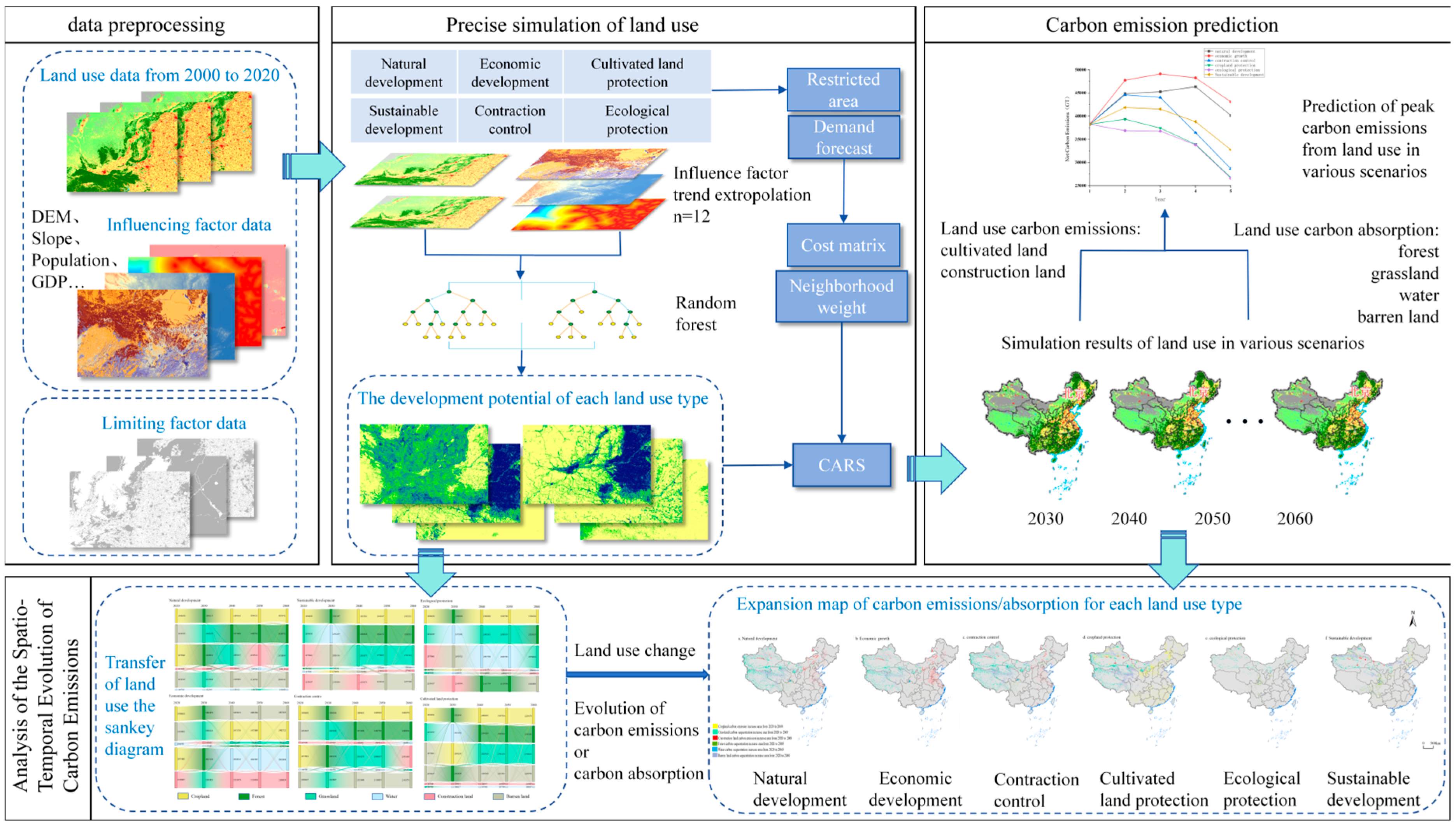
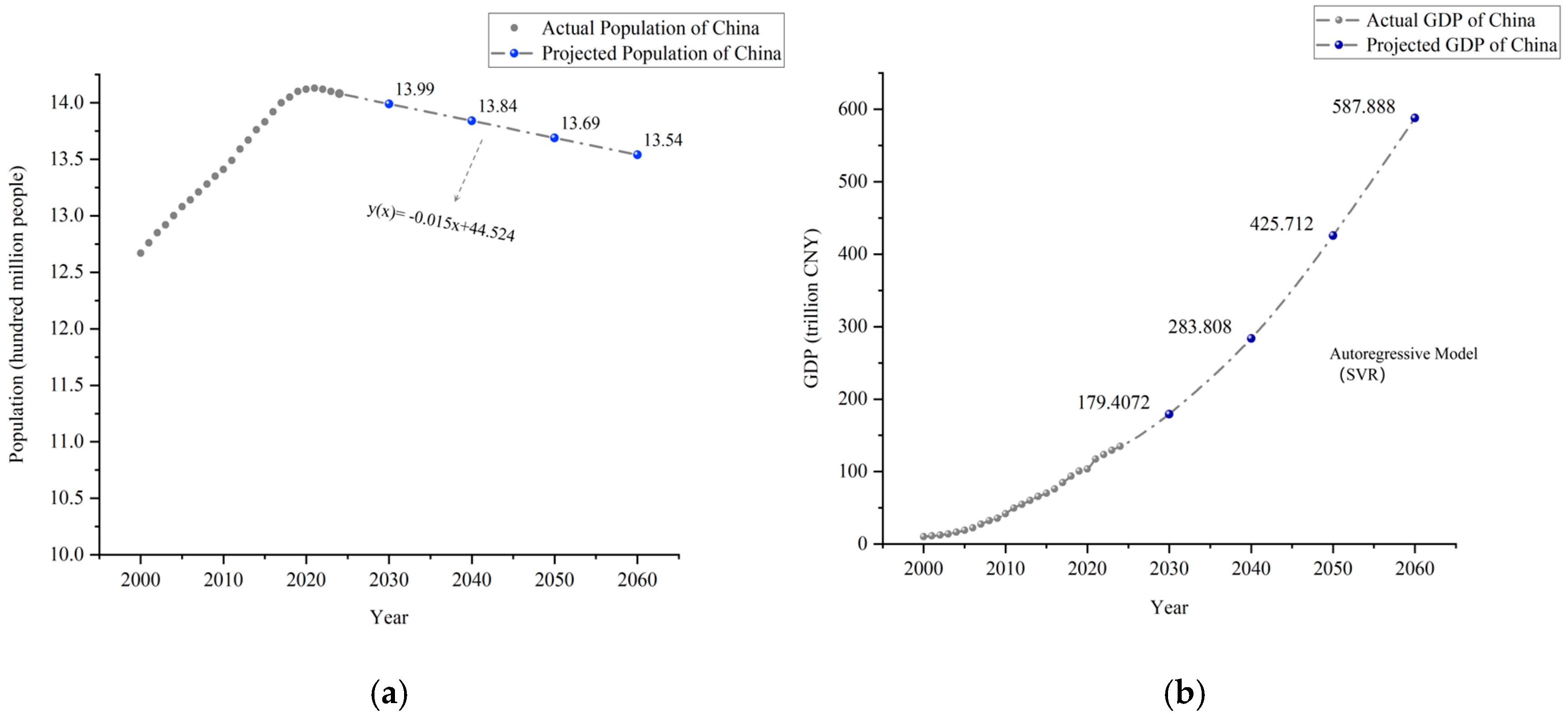
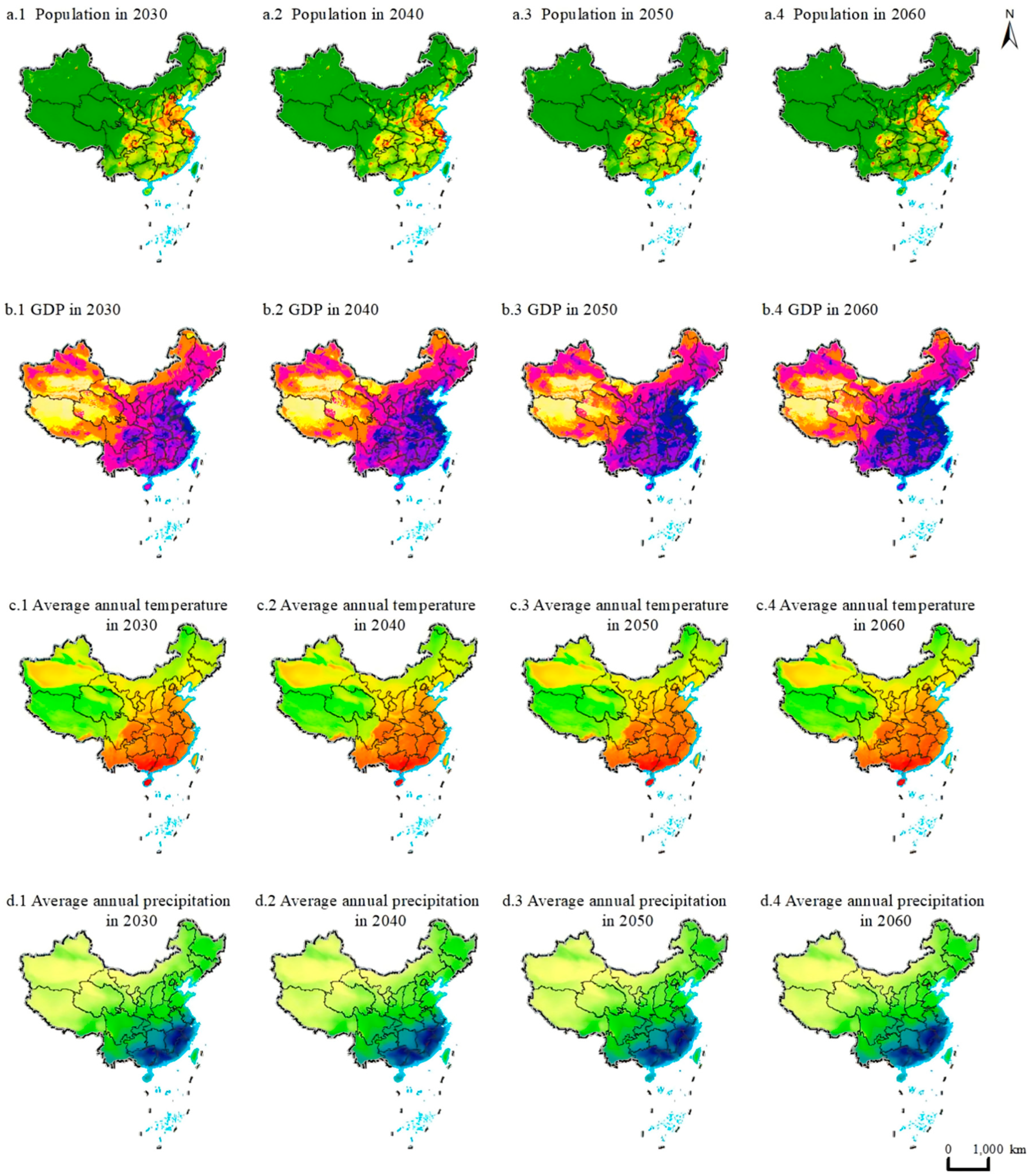
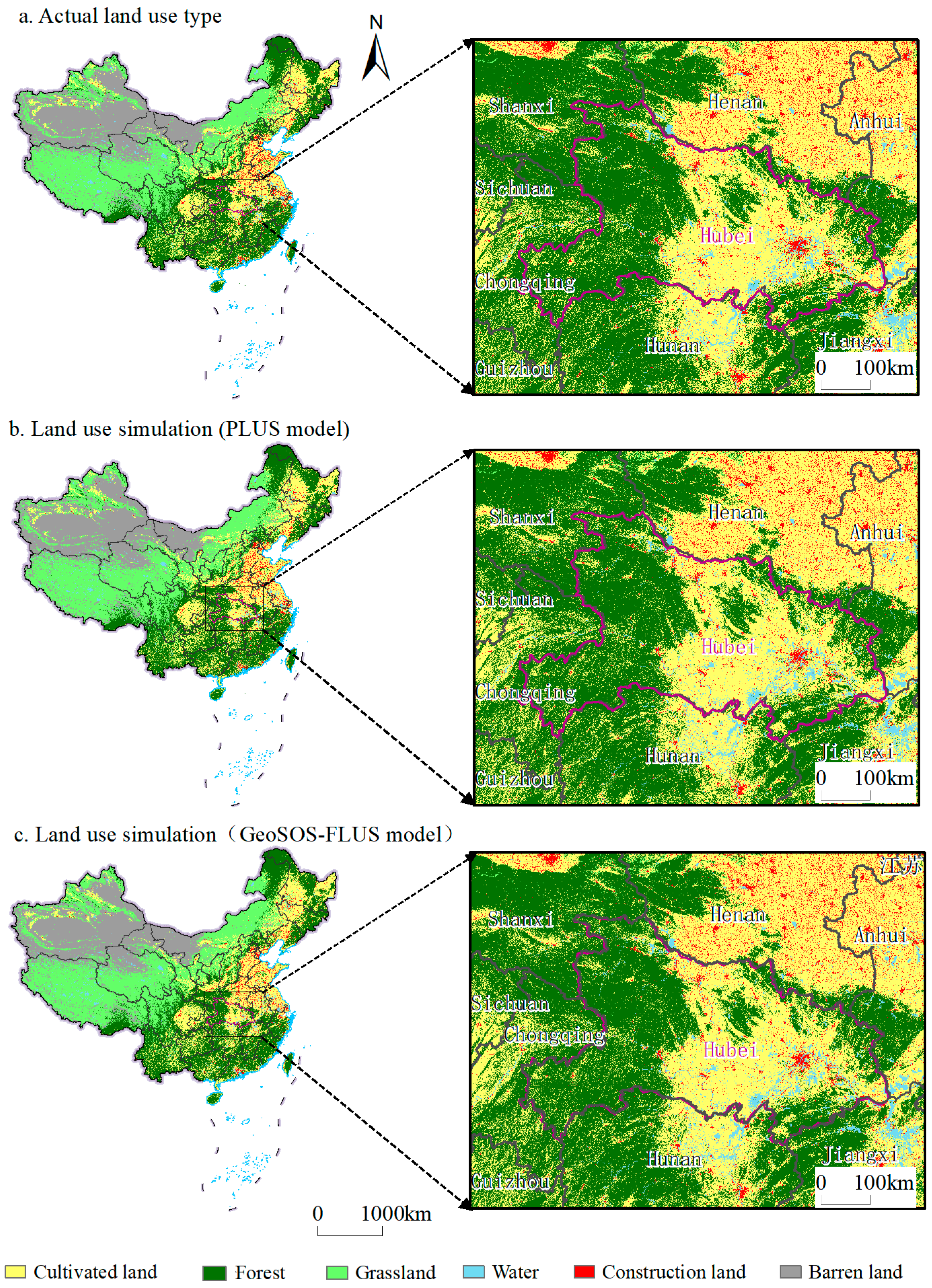
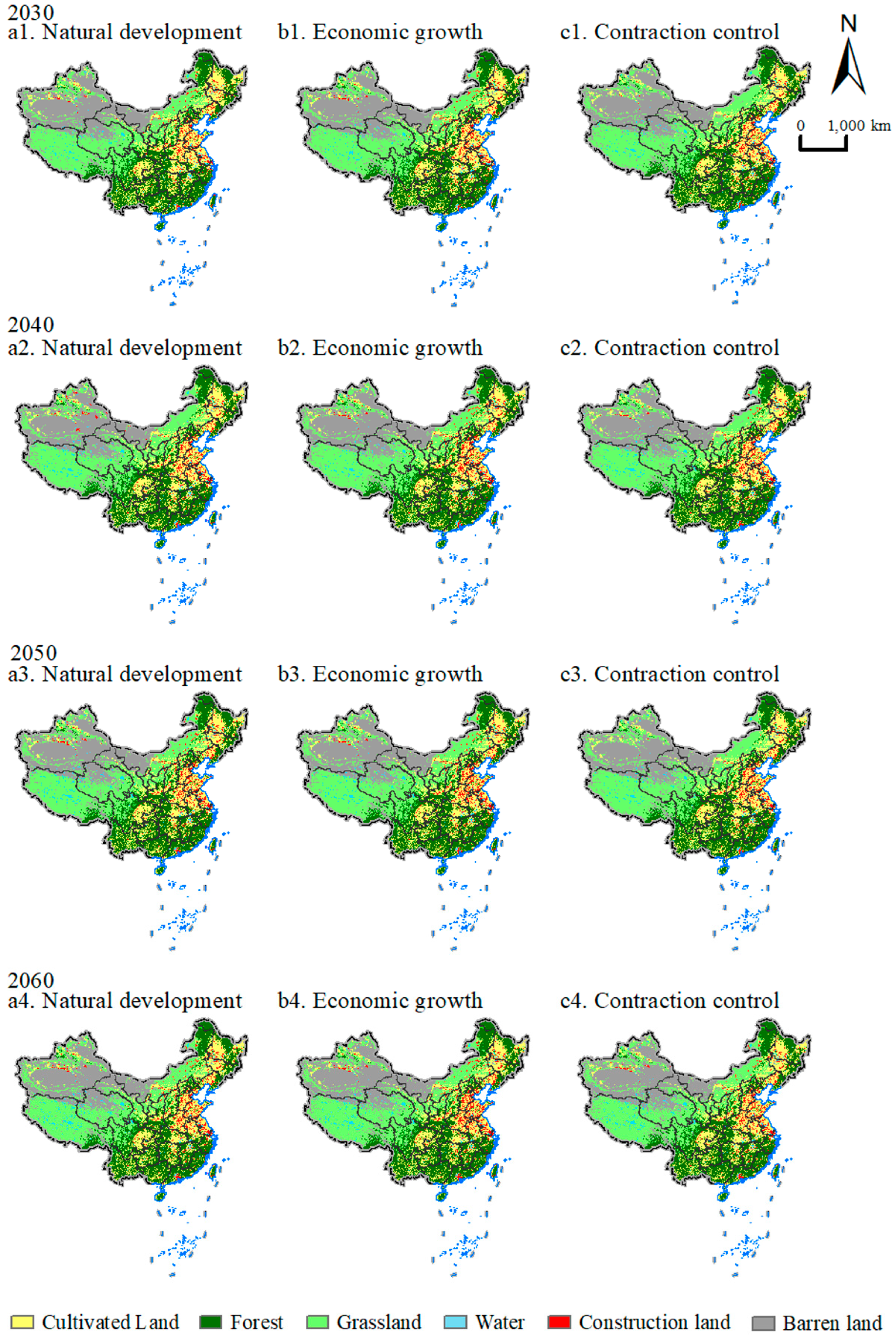
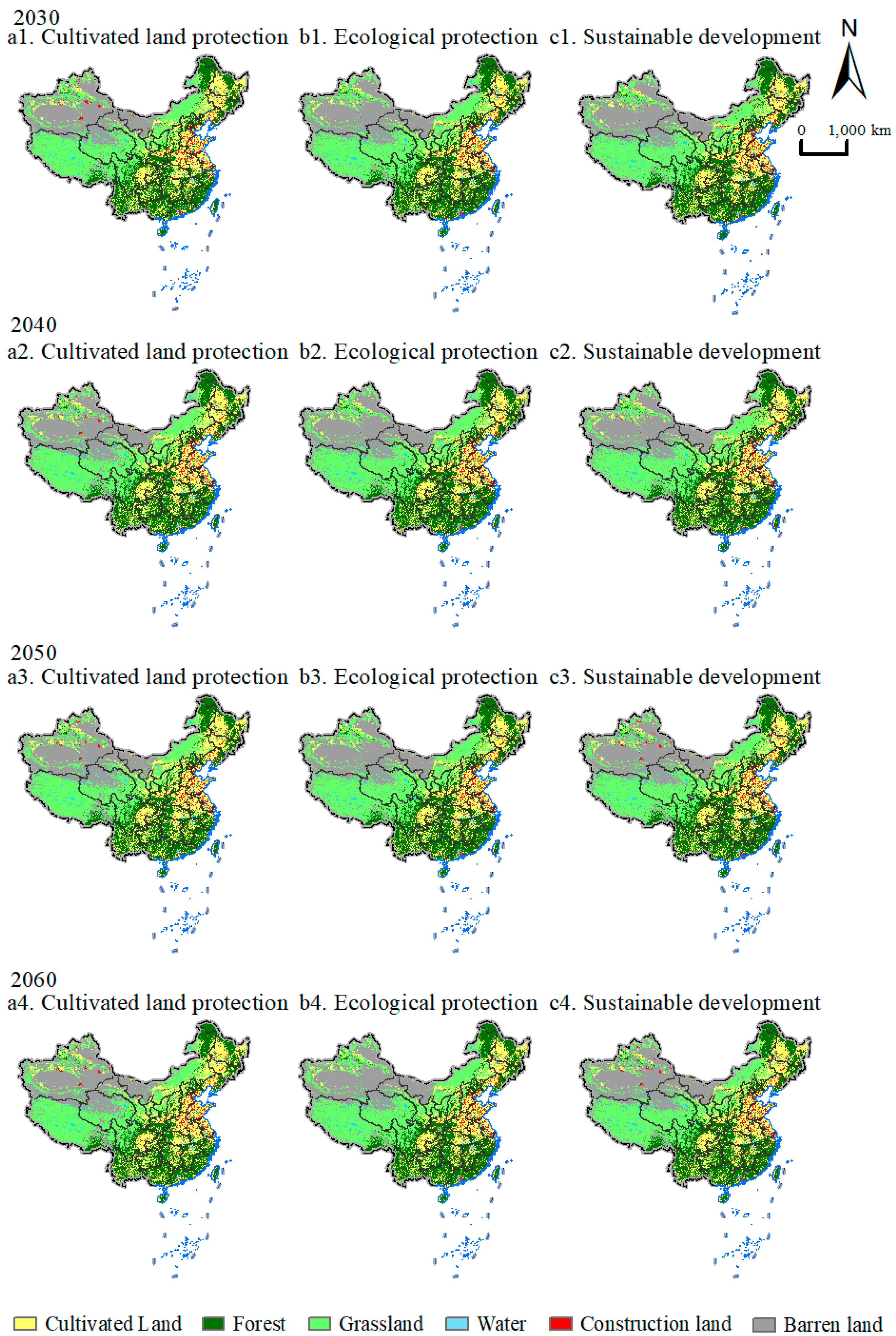

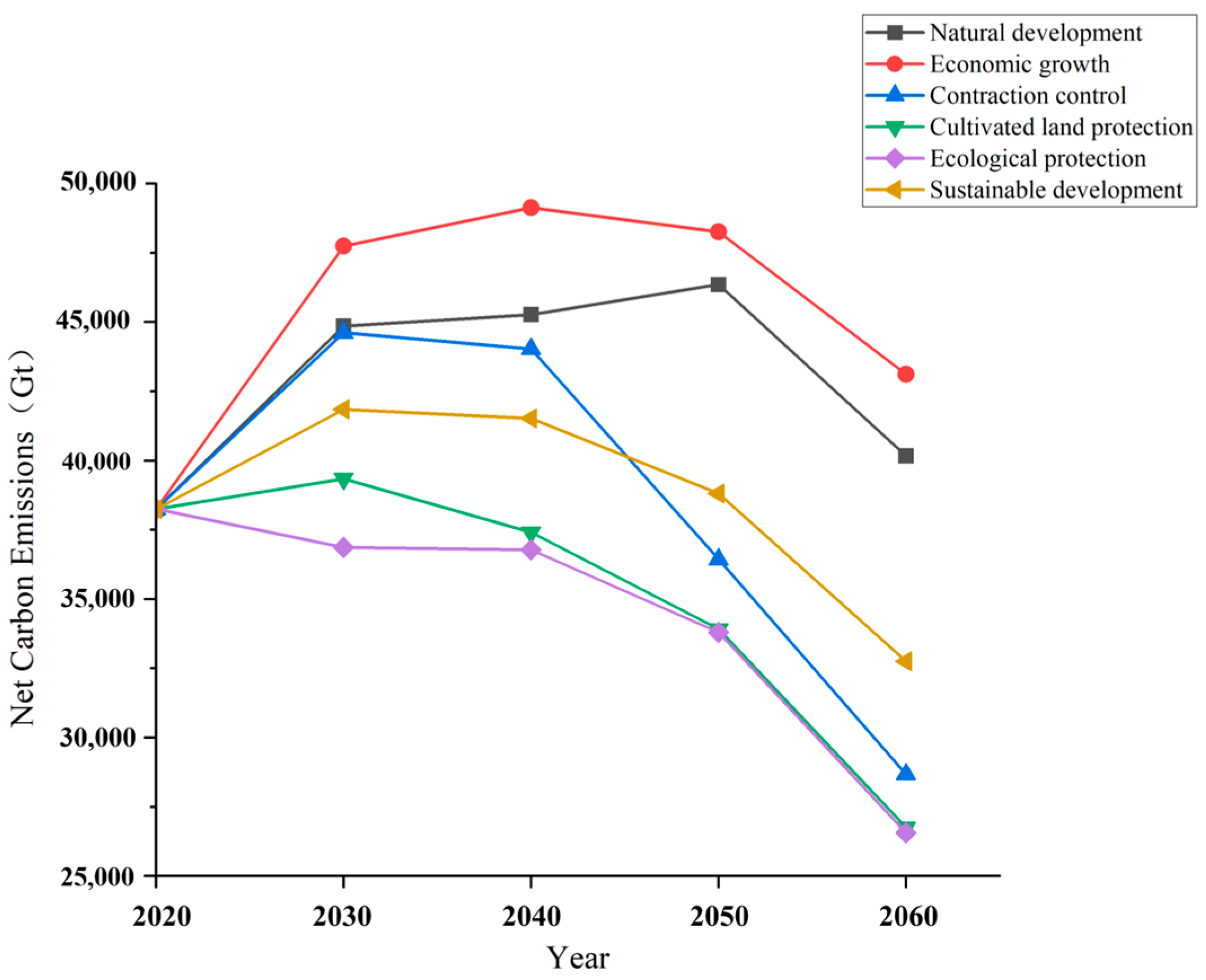

| Data Type | Data Subcategory | Data Description | Data Sources |
|---|---|---|---|
| Land use | Land use data | Three epochs in 2010, 2015, and 2020 with 30 m resolution | https://earthengine.google.com/ (accessed on 24 October 2024) |
| Natural environmental factors | Distance to water | Distance to water bodies such as rivers, lakes, reservoirs, etc. | Taken from 2020 land use data |
| DEM | 1 km resolution raster data | https://www.resdc.cn/ (accessed on 30 October 2024) | |
| Slope | Derived from DEM | ||
| Soil type | 1 km resolution raster data | ||
| Average annual temperature | Average temperature from 2010 to 2020 | ||
| Average annual precipitation | Average precipitation from 2010 to 2020 | ||
| Socio-economic factors | Population | Spatialized expression of population density from 2000 to 2020 | |
| GDP | Spatialized expression of GDP value from 2000 to 2020 | ||
| Distance to railway | Distance to railway | OpenStreetMap | |
| Distance to highway | Distance to highway | ||
| Distance to primary roads | Distance to primary roads in 2022 | ||
| Distance to secondary roads | Distance to secondary roads in Z2022 | ||
| limiting factors | Nature reserve data | vector data in 2022 | |
| Statistical data | Energy consumption data | Provincial consumption of major energy sources | China National Bureau of Statistics |
| Development Scenario | Restricted Conversion Area | Demand Forecast Adjustment | Cost Matrix Setup | Relevant Policies |
|---|---|---|---|---|
| Natural development | / | / | / | / |
| Economic growth | / | The probability of conversion from cultivated land, forest, and grassland to construction land increases by 30%. The probability of conversion from construction land to land types other than cultivated land decreases by 30%. | Restrict the conversion of construction land to other land types. | Restrict the conversion of cultivated land and forest to construction land. |
| Contraction control | / | The probability of conversion from construction land to land types other than barren land increases by 30%. | Restrict the conversion of cultivated land and forest to construction land. | Measures such as downsizing development. |
| Cultivated land protection | Cultivated land protection zones | The probability of conversion from cultivated land to other land types decreases by 50%. | Restrict the conversion of cultivated land to other land types. | Relevant documents such as the delineation of permanent basic cultivated Land. |
| Ecological protection | Ecological conservation zones | The probability of conversion from forest and grassland to construction land decreases by 20%. The probability of conversion from water bodies and cultivated land to construction land decreases by 30%. The probability of conversion from cultivated land and construction land to forest increases by 10%. | Restrict the conversion of forest and water bodies to other land types. Only allow grassland to convert to forest and water bodies. | Relevant documents such as the ecological protection red line. |
| Sustainable development | Integrating Cultivated land and ecological conservation zones | The probability of conversion from cultivated land to other land types, excluding forest and construction land, decreases by 30%. The probability of conversion from forest, grassland, and water bodies to construction land decreases by 10%. The probability of conversion from water bodies and grassland to forest increases by 20%. The probability of conversion from construction land to other land types, excluding cultivated land and forest, decreases by 30%. | Restrict the conversion of cultivated land and forest to construction land. | Relevant documents such as low-carbon development, the achievement of the “dual carbon” goals, and sustainable development. |
| Land Use Type | Carbon Emission Coefficient t/(hm2·a) |
|---|---|
| Cultivated land | 0.4595 |
| Forest | −0.6125 |
| Grassland | −0.0205 |
| Water Bodies | −0.0253 |
| Barren land | −0.0005 |
| Energy Types | Standard Coal Conversion Coefficient | Carbon Emission Coefficient |
|---|---|---|
| Coal | 0.7143 | 0.7559 |
| Coke | 0.9714 | 0.8550 |
| Crude oil | 1.4286 | 0.6185 |
| Gasoline | 1.4714 | 0.5538 |
| Kerosene | 1.4714 | 0.5714 |
| Diesel oil | 1.4571 | 0.4483 |
| Liquefied Petroleum Gas | 1.7143 | 0.5042 |
| Natural gas | 1.2143 | 0.5921 |
| PLUS model | Accuracy Indicators | Natural Development (Fixed Effects) | Natural Development | Economic Growth | Contraction Control | Cultivated Land Protection | Ecological Protection | Sustainable Development |
| Kappa | 0.8205 | 0.9025 | 0.9042 | 0.8803 | 0.8938 | 0.9058 | 0.9101 | |
| OA (%) | 88.39 | 92.57 | 92.70 | 90.28 | 91.91 | 92.82 | 93.15 | |
| FoM | 0.3084 | 0.3717 | 0.3739 | 0.3519 | 0.3538 | 0.3811 | 0.3895 | |
| GeoSOS- FLUS model | Kappa | 0.8014 | 0.8802 | 0.9089 | 0.8631 | 0.8731 | 0.8967 | 0.9028 |
| OA (%) | 86.27 | 91.63 | 91.63 | 83.67 | 90.56 | 90.65 | 91.70 | |
| FoM | 0.2864 | 0.3324 | 0.3421 | 0.3124 | 0.3245 | 0.3502 | 0.3564 |
| Carbon Emissions (Gt) | 2000 | 2010 | 2020 | |
|---|---|---|---|---|
| Carbon Source | Cultivated land | 910.08 | 884.47 | 882.51 |
| Construction land | 18,364.45 | 31,458.41 | 38,951.63 | |
| Total | 19,274.53 | 32,342.87 | 39,834.14 | |
| Carbon Sink | Forest | −1493.73 | −1512.71 | −1519.73 |
| Grassland | −62.07 | −62.18 | −61.16 | |
| Water | −3.55 | −3.88 | −3.95 | |
| Barren land | −1.11 | −1.09 | −1.08 | |
| Total | −1560.46 | −1579.87 | −1585.92 | |
| Net Carbon Emissions | 17,714.06 | 30,763.01 | 38,248.21 | |
| Development Scenario | 2020 | 2030 | 2040 | 2050 | 2060 |
|---|---|---|---|---|---|
| Natural development | 38,248.21 | 44,865.38 | 45,272.08 | 46,359.65 | 40,176.34 |
| Economic growth | 47,743.51 | 49,129.03 | 48,262.58 | 43,118.40 | |
| Contraction control | 44,618.97 | 44,035.37 | 36,441.22 | 28,674.83 | |
| Cultivated land protection | 39,347.88 | 37,414.11 | 33,915.83 | 26,757.12 | |
| Ecological protection | 36,876.28 | 36,780.85 | 33,800.58 | 26,568.24 | |
| Sustainable development | 41,859.07 | 41,526.03 | 38,813.88 | 32,755.43 |
Disclaimer/Publisher’s Note: The statements, opinions and data contained in all publications are solely those of the individual author(s) and contributor(s) and not of MDPI and/or the editor(s). MDPI and/or the editor(s) disclaim responsibility for any injury to people or property resulting from any ideas, methods, instructions or products referred to in the content. |
© 2025 by the authors. Licensee MDPI, Basel, Switzerland. This article is an open access article distributed under the terms and conditions of the Creative Commons Attribution (CC BY) license (https://creativecommons.org/licenses/by/4.0/).
Share and Cite
Zhi, J.; Han, C.; Yan, Q.; Liu, W.; Zhang, L.; Wang, Z.; Fu, X.; Zhao, H. National Multi-Scenario Simulation of Low-Carbon Land Use to Achieve the Carbon-Neutrality Target in China. Earth 2025, 6, 85. https://doi.org/10.3390/earth6030085
Zhi J, Han C, Yan Q, Liu W, Zhang L, Wang Z, Fu X, Zhao H. National Multi-Scenario Simulation of Low-Carbon Land Use to Achieve the Carbon-Neutrality Target in China. Earth. 2025; 6(3):85. https://doi.org/10.3390/earth6030085
Chicago/Turabian StyleZhi, Junjun, Chenxu Han, Qiuchen Yan, Wangbing Liu, Likang Zhang, Zuyuan Wang, Xinwu Fu, and Haoshan Zhao. 2025. "National Multi-Scenario Simulation of Low-Carbon Land Use to Achieve the Carbon-Neutrality Target in China" Earth 6, no. 3: 85. https://doi.org/10.3390/earth6030085
APA StyleZhi, J., Han, C., Yan, Q., Liu, W., Zhang, L., Wang, Z., Fu, X., & Zhao, H. (2025). National Multi-Scenario Simulation of Low-Carbon Land Use to Achieve the Carbon-Neutrality Target in China. Earth, 6(3), 85. https://doi.org/10.3390/earth6030085





